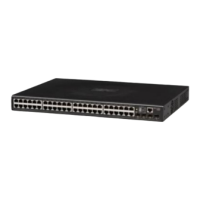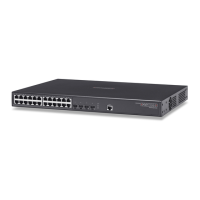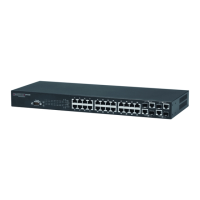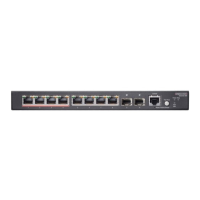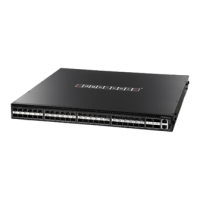Web Configuration
3-37
• Forward Delay – The maximum time (in seconds) this device will wait before
changing states (i.e., discarding to learning to forwarding). This delay is required
because every device must receive information about topology changes before it
starts to forward frames. In addition, each port needs time to listen for conflicting
information that would make it return to a discarding state; otherwise, temporary
data loops might result.
- Default: 15
- Minimum: The higher of 4 or [(Max. Message Age / 2) + 1]
- Maximum: 30
• Force Version – RSTP supports connections to either RSTP or STP nodes by
monitoring the incoming protocol messages and dynamically adjusting the type of
protocol messages the RSTP node transmits, as described below:
- Normal (RSTP Mode) – If RSTP is using 802.1D BPDUs on a port and receives
an RSTP BPDU after the migration delay expires, RSTP restarts the migration
delay timer and begins using RSTP BPDUs on that port.
- Compatible (STP Mode) – If the switch receives an 802.1D BPDU (i.e., STP
BPDU) after a port’s migration delay timer expires, the switch assumes it is
connected to an 802.1D bridge and starts using only 802.1D BPDUs.
RSTP Port Configuration
• Port – The number of a port or all aggregations (i.e., static trunks). Note that the
spanning tree attributes for dynamically configured LACP trunks cannot be
modified.
• Enabled – Enables/disables RSTP on an interface. (Default: Disabled).
• Edge Port (Fast Forwarding) – You can enable this option if an interface is
attached to a LAN segment that is at the end of a bridged LAN or to an end node.
Since end nodes cannot cause forwarding loops, they can pass directly through to
the spanning tree forwarding state. Specifying Edge Ports provides quicker
convergence for devices such as workstations or servers, retains the current
forwarding database to reduce the amount of frame flooding required to rebuild
address tables during reconfiguration events, does not cause the spanning tree to
initiate reconfiguration when the interface changes state, and also overcomes
other STA-related timeout problems. However, remember that Edge Port should
only be enabled for ports connected to an end-node device. (Default: Enabled)
• Path Cost – This parameter is used by the STA to determine the best path
between devices. Therefore, lower values should be assigned to ports attached to
faster media, and higher values assigned to ports with slower media. (Path cost
takes precedence over port priority.)
(Range: 0 for auto-configuration, 1-65535 for the short path cost method,
1-200,000,000 for the long path cost method)
By default, the system automatically detects the speed and duplex mode used on
each port, and configures the path cost according to the values shown below. Path
cost “0” is used to indicate auto-configuration mode.
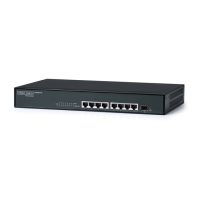
